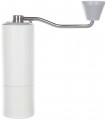The number of grinding levels provided in the coffee grinder.
For different cases may require different degrees of grind, see “Adjusting the grind” for more on this. The same parameter determines how many fixed settings are provided in the coffee grinder. The more of them, the wider the capabilities of this device, the more accurately you can choose the option for a particular situation.
Note that this characteristic is given only for models with millstones (see "Grinding system") — it is not relevant for knife devices. In the most advanced models, the number of grinding degrees can be in the dozens.
The presence
of a removable bowl in the design of the coffee grinder.
This feature is found mainly among knife-type models (see "Grinding system") — it is most relevant for them. Thanks to this bowl, the unloading of ground coffee is greatly facilitated: instead of turning the entire grinder over, it is enough to remove the working container and pour the finished product out of it. Also note that the bowl is usually removed along with the knives — this, in turn, is convenient for cleaning and washing the device.
The material used to make the coffee grinder body.
The key features of the different options are described in detail in separate help paragraphs. Here we note that this parameter affects the appearance, strength and weight of the device, but does not in any way affect the functionality.
-
Plastic. Plastic is inexpensive, but it can be given almost any shade without any problems. Other advantages of plastic are light weight and ease of processing. However, coffee grinders with plastic bodies are noticeably inferior in strength to models in metal casing, and one of the disadvantages of plastic is the tendency to form scratches.
-
Metal. Metal is notable for its high strength and hardness, and coffee grinders with metal bodies look solid and reliable. At the same time, this material is more expensive than plastic, and metal cases weigh significantly more. This option is typical mainly for mid- and high-end devices.
-
Tree. Wooden bodies are rarely found in coffee grinders. As a rule, hand-made models with a millstone grinding system, stylized in an “antique” style, are made from wood. With proper care, such materials are characterized by strength and durability, but over time the wood can dry out and crack.
- Glass. Models in which the part of the body for collecting ground coffee is made of glass. The upper and lower parts
...can be made of plastic, plastic with metal or pure metal. Often the glass is made transparent, much less often - matte. Glass products have an aesthetic appearance and provide the opportunity to observe the process of grinding coffee beans. However, this is a very fragile material.
- Ceramics. Stylish ceramic bodies give coffee grinders a special chic - this is an perfect material for models designed in a retro style. In addition, ceramic cases are usually complemented with original designs and patterns. One of the disadvantages of ceramics is fragility, however, due to its relatively large thickness, only a fairly strong blow can break it.


